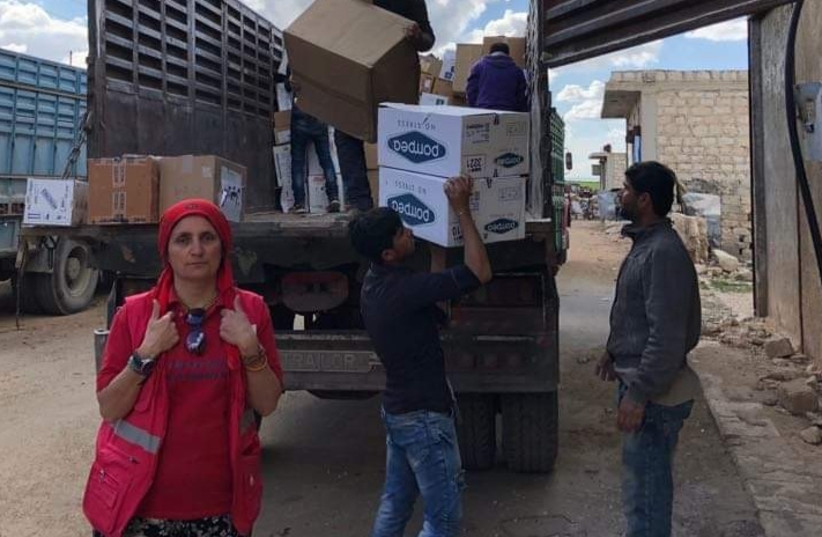Dr. Nemam Ghafouri, activist who helped Yazidis in Iraq, Syria passes away
Dr. Nemam Ghafouri, activist who helped Yazidis in Iraq, Syria passes away
Everyone knew her. News of her death has case a shadow over many who worked quietly raising awareness about suffering of minorities across northern Iraq and Syria.

Dr. Nemam Ghafouri delivering humanitarian aid.
(photo credit: Courtesy)
Dr. Nemam Ghafouri was always there. Wherever there was suffering in Iraq and Syria, especially among Yazidis
who had been targeted for genocide by ISIS, the Kurdish-Swedish
doctor’s name would come up. Everyone knew her. News of her death has
cast a shadow over many who worked quietly raising awareness about
suffering of minorities across northern Iraq and Syria.
Ghafouri
died of Covid in Stockholm, Sweden. She was 52. According to Wladimir
van Wilgenburg, a writer at Kurdistan 24, Ghafouri was born in 1968 in
the Kurdish region of northern Iraq. She fled Saddam Hussein’s regime
with her family at a young age, first to Iran and then to Sweden. Many
thousands of Kurds, facing genocide under Saddam, went this route.
Ghafouri would come back, founding the group Joint Help for Kurdistan,
in 2014. This was during the ISIS genocide. Yazidis were fleeing the
area of Sinjar as ISIS was rounding up women and children for
enslavement. Long after the genocide began and many had forgotten the Yazidis
who were living by the hundreds of thousands in refugee camps, Ghafouri
would continue struggling to help them. She would travel the lonely
roads, through the checkpoints, to help people fleeing Afrin in 2018.
She was able to get places that others could not, using locals and
connections on the ground, and the angel-like respect and admiration she
had accumulated over the years in the region. Recently
she was named in a piece in the New York Times as one of the key
individuals behind helping some Yazidi women reunite with their children
in a secret operation. She was also mentioned in a 2016 article in the
‘Times’ as an ever present face helping Yazidis in the area.
I
spoke to Dr. Nemam back in 2018 when she was very frustrated about the
international organizations that always use “beautiful words” but never
seemed to follow through and do anything for victims of ISIS. She was
shuttling back and forth between camps and Dohuk in northern Iraq,
dealing with humanitarian bureaucracy. She would detail how she worked
tirelessely, sitting in her car all day waiting to receive Yazidi
survivors who were able to escape the clutches of ISIS. She met with
women who had suffered untold horrors. One story she told me was about a
Shi’ite Muslim girl whose mother had been raped and murdered by ISIS.
The mother’s last instructions to the girl, to keep her alive, was for
the girl to claim she was Yazidi so she will be enslaved and not killed
by the ISIS extremists. The girl survived.
The Kurdish doctor tried her
best to help these young people with an ever-present smile. She was
optimistic but frustrated by the inaction of the international community
and the bureaucracy of local structures. Yazidis who survived genocide
suffered numerous hurdles upon return. Some could not return with
children they had during their captivity because of religious laws in
Iraq. Ghafouri was
respected and liked by people on all sides, something that is rare in
the regions of northern Iraq and eastern Syria where deep political
divisions often mean people don’t get along. She would visit with the
Yazidi fighter Qasim Shesho one day in Iraq and be in eastern Syria the
next and then in the pleasant city of Dohuk. How she was able to do what
she did, crossing borders and political lines that many are unable to,
was always a mystery to those who followed her closely. She seemed to be
able to melt into the fabric of local societies, moving among people
and refugees like the water, and then emerging in some far away place
bringing humanitarian aid. And then she would be back in Sweden or
somewhere else, encouraging people to continue to care about the young,
the poor and the women survivors of genocide.
“When
I was in Kobane people were sending me messages about how bad it was,”
she told me in 2018, discussing Syria. “And Turkey was threatening to
attack Sinjar and people were desperate and people wanted to leave. But
the Iraq government said anyone who leaves, they can only bring with
them 5 kilos of stuff with them. So they could not move back. It was
really difficult to get any medical support or humanitarian aid.” She
recalled the situation in Sinjar in 2018. She went to Mosul, recently
liberated from ISIS, and said “the only thing I was hearing in my head
was the voices of girls and children who told me their stories who had
been raped in Mosul hospital, taken around in Mosul, or the last girl
who came back from Mosul with her baby, and that the baby was taken away
because her father was ISIS; this is what was going on in my mind and
soul.”
She told the harrowing stories of the genocide. “I have video of a
girl who was asked to go back to Mosul to get papers [after the
genocide] and when she went she saw in the civilian’s eyes the people
who under ISIS were worse than ISIS. At night time when ISIS members
would rape her, and in the day the wife [of the ISIS member] would burn
her and accuse her of having sex with her husband, and these were
civilians and these rapists went free.” They went free like the Nazis
after the Holocaust who just pretended to be civilians.
“It was not an easy journey but I still adore those women and children forced to go back there. After all they have been through.” Ghafouri kept going back to help those women.
Kommentare
Kommentar veröffentlichen